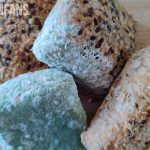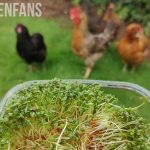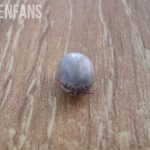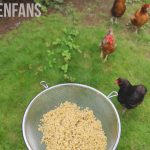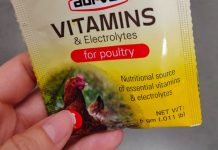Can Chickens Eat Strawberries? (And what to avoid)
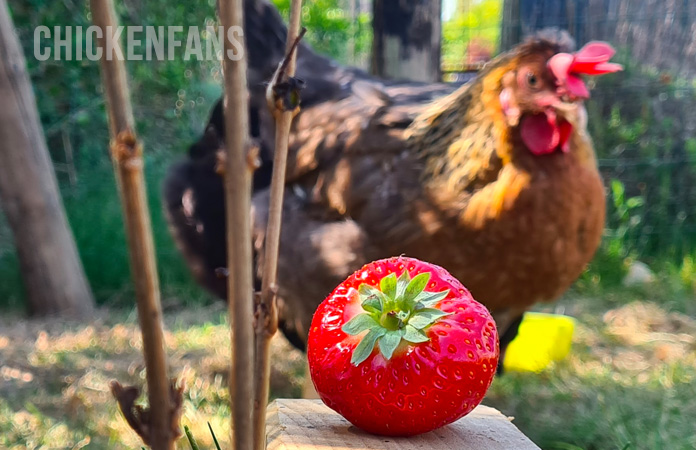
Chickens can eat fresh strawberries as an occasional sweet treat. However, there are some caveats, and they should not eat the tops, stems, or leaves.
We discuss the benefits of strawberries and what to avoid.
- Can chickens eat strawberries
- Nutritional Value of Strawberries for Chickens
- Can Chickens Eat Strawberry Tops, Stems, and Leaves?
- What are the Dangers of Feeding Strawberries to Chickens?
Main takeaways:
- Chickens can eat fresh strawberries in moderation
- Strawberries are a treat and high in sugar
- Avoid feeding tops, stems, and leaves
- Wash them very well and make sure there is no mold
- Prefer organic food over store-bought berries
- Don’t feed jams or processed food
Can Chickens Eat Strawberries?
Adult chickens can eat fresh strawberries, but not the tops and leaves, as those contain a toxic cyanide compound that upsets their digestive system. Strawberries are high in sugar and can be an occasional treat if they are washed and free from pesticides and mold. Chicks should not eat strawberries.
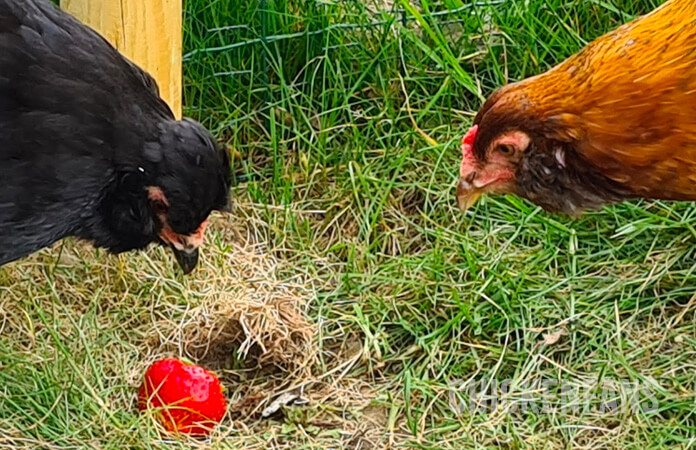
Nutritional Value of Strawberries for Chickens
Strawberries are 90% water, and as a feed, they have very low nutritional value for chickens. They hold almost no proteins or fats, and nearly all of the carbs come from sugar.
| Strawberries (100g) | Amount | % DV Laying Hen |
|---|---|---|
| Calories | 33 | ~10% |
| Water | 90 g | – |
| Protein | 0.64 g | 0.04 % |
| Carbs | 7.96 g | – |
| Sugar | 4.86 g | ~12% |
| Vitamin C | 59.6 mg | ~ 60% |
| Biotin (Vitamin B7) | <3.7 µg | ~ 2% |
| Folate (Vitamin B9) | 24 µg | ~ 5% |
| Potassium | 161 mg | – |
| Manganese | 0.368 mg | – |
| Calcium | 18 mg | ~ 0.5 % |
Strawberries are high in vitamin C, an important antioxidant that reduces oxidative stress and the risk of heart disease and cancer.
They also contain some vitamin B9 (folate) used for cell growth, red blood cells, and DNA repair. It’s minimal, as 100g will only bring about 5% of the daily intake for an adult Leghorn pullet. However, every supplementation helps as a chicken’s body can not make folate.
Strawberries also contain minerals like potassium and manganese, which are essential for the chicken’s metabolism. However, they also get those minerals from almost everything else they eat.
Can Chickens Eat Strawberry Tops, Stems, and Leaves?
Chickens should avoid eating the strawberries’ tops, stems, and leaves even when washed thoroughly. However, they will probably have no trouble eating them, and chances are small they will get sick.
Strawberries are members of the rose family, like apples. All these fruits produce small levels of highly toxic hydrogen cyanide. It’s a defense mechanism of the plant to deter insects. When a strawberry is picked, hydrogen cyanide gas is released through the leaves.
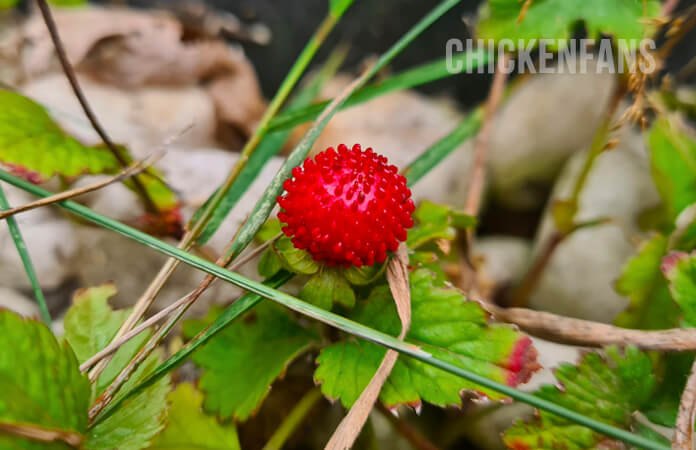
How toxic is hydrogen cyanide, and how much of it is in strawberries?
Hydrogen cyanide concentrations of 100-200 ppm in breathing air kill a human in 10 to 60 minutes. The gas is used as a deadly poison in chemical warfare. It damages the heart and blood vessels and destroys the cilia, the tiny hairs in the airways of the respiratory system.
Tobacco smoke contains about 50-100 ppm hydrogen cyanide. Strawberries only hold about 6ppm, which is a minimal amount. However, it’s not zero either, and the release of hydrogen cyanide in the early weeks of the decay process affects the chicken’s health.
How safe are strawberries?
There’s only limited scientific research on the effect of hydrogen cyanide on chickens. However, it’s very well known that chickens are much smaller and have a sensitive respiratory and digestive system. So we recommend removing the tops when feeding them table scraps.
The gas is gone when the leaves have dried out, so it’s perfectly safe to consume dry strawberry leaves or make herbal tea.
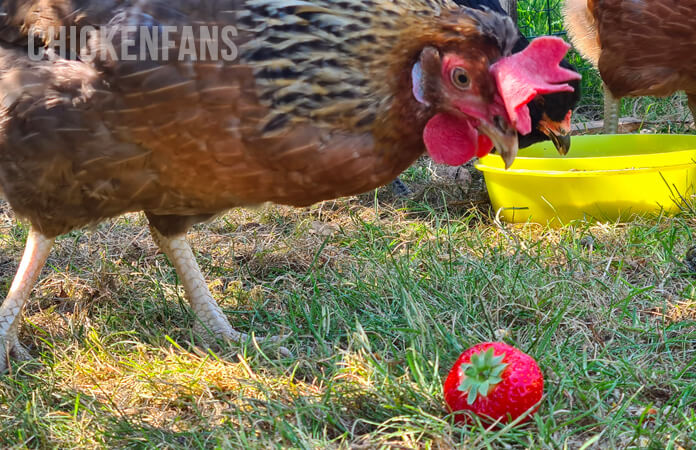
What are the Dangers of Feeding Strawberries to Chickens?
It’s generally safe to feed strawberries to chickens, but there are a few things to be aware of and avoid.
The dangers of feeding strawberries are:
- Pesticides: strawberries take the number 1 position on the Environmental Working Group (EWG) 2022 Dirty Dozen List. It’s an annual list of fruits and vegetables based on the most amount of pesticides found in food samples. Always wash strawberries, as pesticides can be very harmful to chickens. Organic strawberries are always a better choice than store-bought fruit.
- Sugar: strawberries are so sweet because they are almost entirely made up of sugar. Most of the sugar is glucose and fructose, both good for about half of the sugar concentration. They come with a high glycemic index, spiking sugar concentrations in the blood. Too much sugar can cause Sour Crop and health issues.
- Hydrogen cyanide: when strawberries are picked, and the fruit is in the early stages of decay, the leaves release small concentrations of poisonous hydrogen cyanide gas to deter insects. We recommend avoiding the tops, stems, and leaves to be safe.
- Mold: only feed fresh strawberries that you would eat yourself. Molds are dangerous for chickens, affect their digestive system, and can cause dangerous infections.
Sugar
Chickens don’t handle the high sugar levels in strawberries very well. The birds are naturally insulin-resistant, and their body doesn’t pull the excess sugar out of the bloodstream. This can cause a state of hyperglycemia.
Hyperglycemia causes high blood pressure, inflammation, weight gain, diabetes, liver problems, and many other diseases. The insulin resistance varies per breed. For example, Silkies have a stronger ability to regulate the glucose in strawberries than broiler chickens.
Any processed strawberry food comes with high sugar concentrations. Avoiding all kinds of jams, jellies, juices, or any processed foodstuff with preservatives is best.
Further Reads
Other popular food articles that come with some surprises:
- Can chickens eat onions – the risks and how onion usage as poultry supplements
- Can chickens eat chocolate – several variants of chocolate are toxic to chickens
- Can chickens eat and taste spicy food – discussion on the taste of chickens
- Can chickens eat grapes – yet another popular sweet fruit similar to strawberries
- Can chickens eat mango – another popular fruit that’s researched to substitute poultry feed
- Oranges – the benefits and risks of feeding oranges to your flock
- Pineapple – the tropical fruit that burns the tongue
Some articles we mentioned here:
- The chicken digestive system – how chickens digest their food
- The chicken respiratory system – how chickens breathe and why it’s so different from how we breath
If you want to learn more about chicken feed, please consult our ‘Chicken Food Page‘ to go and see every specific food article we address, including all articles on what chickens can and can not eat. Or go to our listicle food summary on ‘The Classroom‘.
